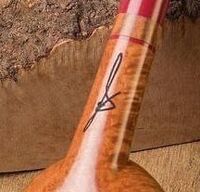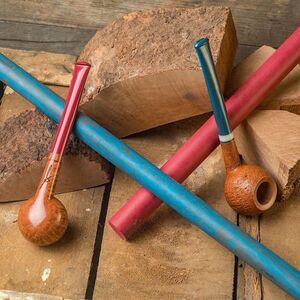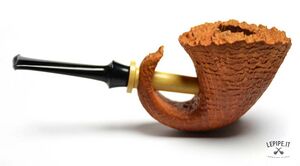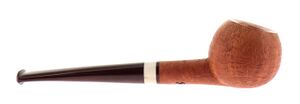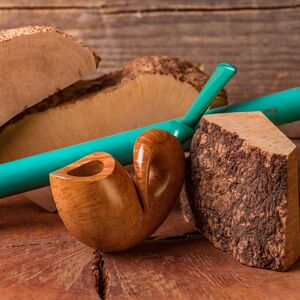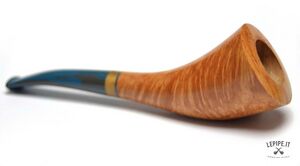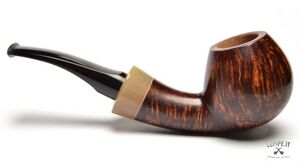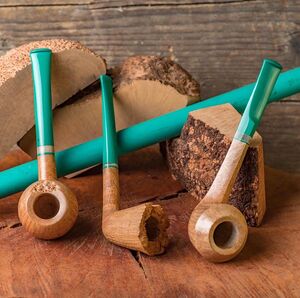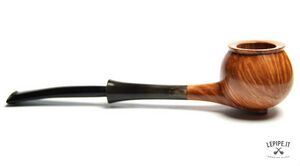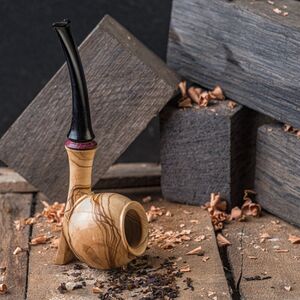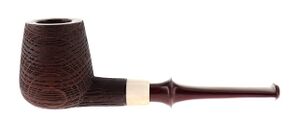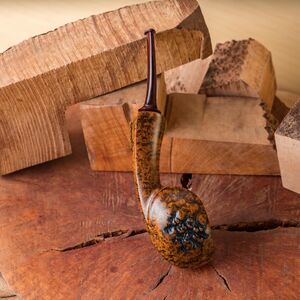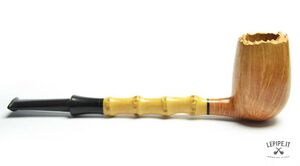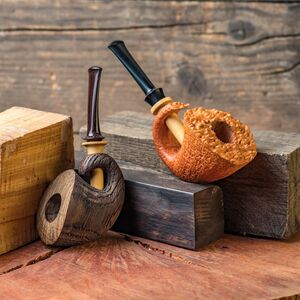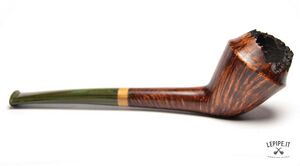Brentegani Pipe
Brentegani pipes are made by Michele Brentegani (b. 1989), an artisan pipe-maker from Verona, Italy, and an alumnus of Italy’s Accademia della Pipa.[1]
A lifelong woodworking hobbyist, Brentegani developed his skills crafting such diverse artifacts as bows and bamboo flutes. In 2015, he turned his attention to pipes.
Brentagani’s introduction to pipe-making happened by chance. Originally graduating as a practitioner of traditional Chinese medicine and tui na, an ancient, Daoist form of massage therapy, Brentegani became enamoured with pipes after being shown a friend’s churchwarden. After examining the churchwarden, Brentegani immediately wanted to make one himself, so he found some wood and crafted a stummel with what he already had on hand. The stem presented a bigger obstacle, however, as Brentegani at this point had no idea how pipe stems are made, nor where he should find the materials to make one. After an email conversation with someone at Brebbia, one of Italy’s most prominent pipe manufacturers, who revealed to him a little about the logistics of sourcing materials, Brentegani was surprised a few days later by the arrival of three brand new pipe stems, courtesy of the Brebbia company. Brentegani remembers and remains grateful to Brebbia for this act of kindness and support to this day.
Brentegani’s pipe-making was initially self-taught and was undertaken part-time for the first years of his new craft. Later, after reaching out to other pipe-makers, he was given guidance by figures such as fellow Italian Ulrik Ash of Pipe Ulrik. In 2018, Bretegani Pipe had its first exhibition at Triveneto’s PipAlp festival. In 2020, Brentegani was accepted into the highly selective Italian pipe-making academy, l’Accademia della Pipa, where he received a more formal tutelage under mastri Gabriele Dal Fiume, Davide Iafisco, Mimmo Romeo, and Gioacchino Sauro. That same year, Brentegani took up pipe-making as a full-time career.
Brentegani professes a fondness for both classical pipe shapes and those of the post-1950s Danish scene. If one examines his catalog of recent and past works, one finds plenty of artisan staples in the vein of the latter; elephants feet, speared fish, bent eggs, to name a few. But one also finds a great many more traditional pieces, such as billiards, brandies, and princes. Then, there is a third category of Brentegani pipes expressing a synthesis of the first two, which might be called ‘neoclassical.’ These pipes are strongly reminiscent of the English-French classics, but possess one or two left-field alterations. The shank of what would otherwise be recognizably a prince might continue beyond the bottom of the bowl, in the style of a calumet; a Rhodesian might bear a forward cant, or a touch of exposed briar plateau; the typically straight, horizontal or vertical lines of a Dublin might be subtly rounded inward, giving it a concave profile.
Despite this variety of forms, there are two properties that are possessed by the majority of Brentegani pipes: one being their literal and figurative lightness; and the other being their unconventional uses of color. The former property is something praised by Diego Morlin in his La pipa: I migliori marchi Italiani, who refers to Brentegani pipes several times as being ‘light,’ both in their subtle and refined composition and in that they rarely exceed 35 grams in weight. As for color, Brentegani pipes are quite distinct in their willingness to employ bold colors – typically, but not exclusively, in the hue of the stem – and to juxtapose these colors in the final product. While Brentegani is certainly not the first to explore out of the ordinary color schemes in his pipes, his approach is far removed from the audacious or otherworldly designs of someone like Chris Askwith or Chris Kelly of Eldritch fame. The closest parallel would instead likely be the Smith House pipes of Rich Rosselli. Like Rosselli, Brentegani’s ebonite stems are bold, but still relatively modest, featuring shades of sea-foam green, of magenta, or, as are seemingly most favored by the artisan, of azure or lapis blue. For the stain used on his stummels, Brentegani appears more reserved, but it is clearly observable that a conscious and careful decision is made when pairing the colors worn by his stummels, stems, and other decorative elements, such as horn or bamboo. This sensitivity and talent for selecting appropriate color combinations is evident whether Bretegani is using quintessentially Italian blonde briar, earthy black or brown bog oak (morta), or tanbark olive wood.
It has been several years since Morlin appraised Brentegani’s work, where he stated that the latter is “a young man who as self-taught has managed to create a space for himself among the Italian pipe makers.” Though Brentegani now has some expert training under his belt, Morlin’s claims about his successes in the competitive world of artisan pipe-making appear more accurate than ever. Brentegani’s pipes have been sold by LePipe.it, Lupidi, Tabaccheria Floppy, and Tabaccheria Guzzi in Italy, and more recently by Cigarworld in Germany. In 2021, Brentegani had the honor of making pipes for the 21st anniversary of the Italian pipe shop, LePipe.it (see left).
Gallery
Contact Information
Michele Brentegani Email: brenteganipipe@gmail.com Facebook: https://www.facebook.com/brenteganipipe/ Instagram: https://www.instagram.com/brenteganipipe/
- ↑ Information for this article was provided to the author by Michele Brentegani.

